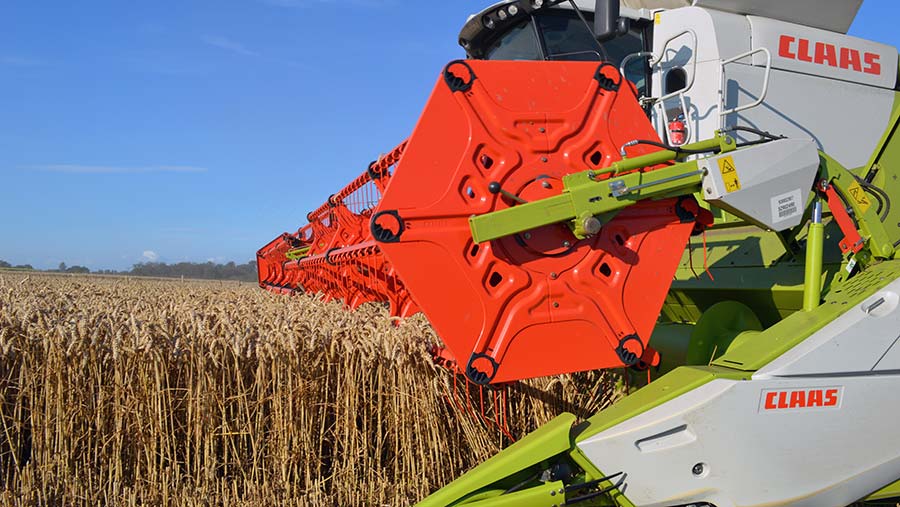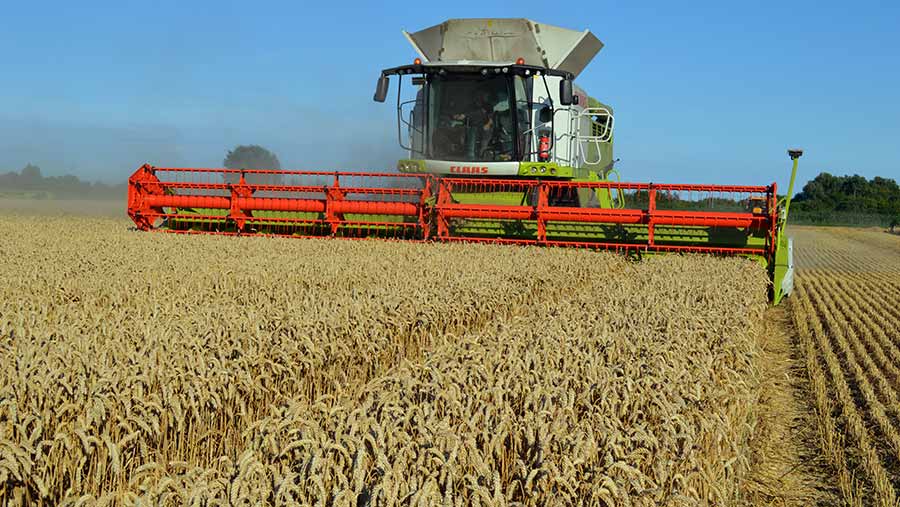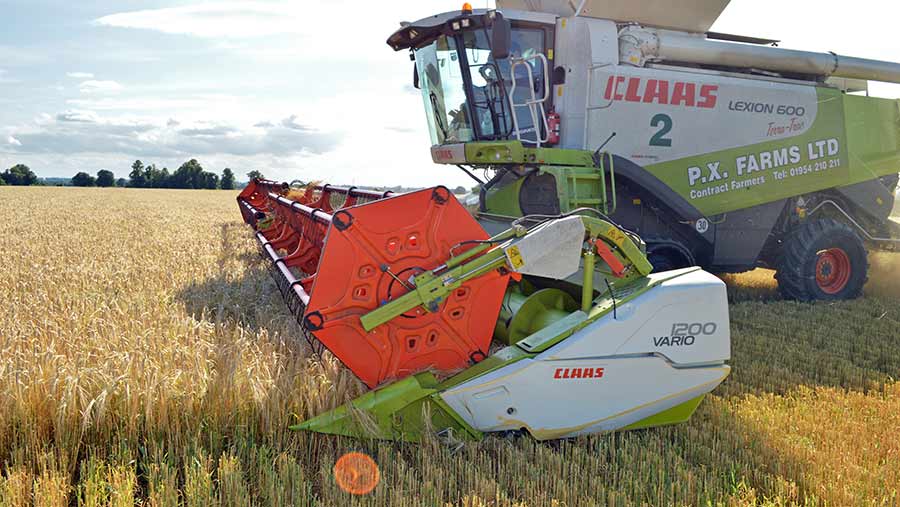Video: Rain threatens to put a dampener on wheat harvest
 © David Jones/RBI
© David Jones/RBI Rain is threatening to put an early dampener on the wheat harvest after a scattering of early-maturing milling crops have shown very good grain quality.
Crops harvested in Cambridgeshire and Kent have produced good grain samples meeting the millers’ needs, while many elsewhere have combines parked up, waiting for the rain clouds to dissipate.
In one of the earlier wheat harvests on record, grain yields are also looking good, despite a difficult season that featured a cold spring, followed by a heatwave in June that brought crops to early maturity.
See also: Harvest spreads north and west between the showers
Early wheat in Cambridgeshire
In Cambridgeshire, George Palmer reports yields of the early-maturing milling variety Gallant at 10.5-12t/ha on some light land on the edge of the fens. The quality is up to the millers’ requirements.
The farm manager at Northfield Farms, south-east of Ely, said the farming group started cutting wheat on 21 July and had combined 80ha of its 800ha total last week (pictured below). However, harvest is now being held up by wet weather.

The early yields of Gallant are matching the farm’s 10-year average, and there is Skyfall, Santiago and Reflection still to cut on the group’s 2,000ha of land that range from sandy loams to fenland soils.
Watch the video of the wheat harvest at Northfield Farms below.
“The harvest is going okay. We are reasonably pleased and pleasantly surprised, as we were expecting a lot worse after a difficult year,” Mr Palmer told Farmers Weekly.
His Gallant is showing grain proteins of 12-13.5%, with most over 13%. Specific weight is in the high 70s, with a top sample at 82kg/hl and the grain is being delivered to co-operative Camgrain.

Antony Redsell © Oli Hill/RBI
Pleasing quality
Further south, Kent grower Antony Redsell is pleased with the yields and quality of the 60ha wheat he has cut of another early-maturing milling variety, Cordiale, which is showing a yield of about 10.5t/ha.
After a very dry season that forced him to irrigate some wheat, he is relieved that quality is good, with specific weights of up to 82kg/hl, proteins at 14% and high hagberg scores.
“So far, so good. I’m very happy after everything that has happened this season. We are two weeks ahead of normal despite the late rain, which helped the crop senesce naturally rather than dying off early,” he said.
See also: More harvest 2017 coverage
Rain put a stop to combining last weekend after 5-10mm fell, but Mr Redsell said time is on his side because the harvest has come so early. He grows 400ha of milling wheat at the Brook Farm Partnership, near Herne Bay on the Kent coast.
Other wheat varieties yet to cut are Skyfall, Trinity and Crusoe, which form part of his six-year rotation that also includes two spring break crops and maize for anaerobic digestion.

James Loder-Symonds © David Jones/RBI
Surprises in Kent
Further south in Kent, James Loder-Symonds reports good yields and quality from the winter wheat he cut last week before the rains.
Out of 400ha of wheat grown at Nonington Farms, halfway between Canterbury and Dover, some 70ha of Skyfall grown as a second wheat and 60ha of Crusoe as a first wheat have been cut.
Quality is good, with proteins at more than 13%, specific weights above 76kg/hl and hagbergs of 350-plus on a farm that has often struggled to achieve high proteins from top-yielding crops.
“The wheat has been surprisingly good given the season and we are really pleased with the early results,” he said.
Spring barley
James Peck in Cambridgeshire has moved to cut spring barley ahead of his winter wheat, and the malting barley variety Planet was showing good yields of 7.5-8t/ha when he started cutting on 21 July.
Mr Peck has cut wheat for a neighbour, but has now moved to spring barley on his 2,400ha. The grain was a little damp, but he believes malting barley needs to be cut while it is still standing.
Watch the video of spring barley being cut at PX Farms below.
“We are hoping for 7.5-8t/ha, and if it does 9t/ha, I will take all the staff to the pub,” he said.
Despite growing the crop on chalky boulder clay, he has met the low nitrogen needs of the malting industry for the past four years at Scotland Farm, Dry Drayton, just west of Cambridge, largely because of better modern varieties.
Waiting for dry weather
Meanwhile, growers in Oxfordshire, Dorset, Suffolk and Hertfordshire were waiting for better weather to start on their winter wheat harvest or even switch to spring barley like Mr Peck.

In Cambridgeshire, James Peck is hoping to achieve a yield of 7.5-8t/ha from his malting spring barley © David Jones/RBI
James Price in Woodstock, near Oxford, is ready to cut 280ha of milling wheat after harvesting 80ha of oilseed rape with an average yield of 3.6t/ha on his Cotswold brash soils.
“We are ready to go, but if we have a sustained period of wet weather, this may hit quality,” he said.
Down in south Dorset, farm manager Martin Ford has just cut 300ha of oilseed rape and is very happy with his yield of 4.4t/ha. Next he may turn to spring barley rather than winter wheat.
After 35mm of rain at the weekend, he is looking to cut 200ha of the spring malting variety Propino ahead of his feed winter wheat on the farm.
“The spring barley looks good and we are hoping to make a start this week,“ he said.
Also in Dorset, Jim Farquharson at Eastbury Estates, near Blandford Forum, is waiting to cut a mix of Skyfall, Crusoe and Illustrious milling wheats after his oilseed rape yielded 3.6-4.0t/ha and hybrid winter barley 8.6t/ha.
On the Suffolk Brecklands at the Euston Estate, farm manager Matthew Hawthorne is waiting to start cutting 280ha of milling wheat this week, while Andrew Bott in Hertfordshire is also awaiting better weather to start on his milling crops.
Grain quality
Rob Munro, managing director of co-operative Fengrain, said wheat quality is generally good and the milling grain he has seen is quite pleasing despite the recent rain.
He is seeing varieties Skyfall and Gallant coming into his stores, and is starting to see some Propino spring malting barley in the very early stages of harvest.
Philip Darke, managing director of Camgrain, said earlier this week the group had seen 10,000t of wheat delivered and the quality is looking fine.
Traditional milling wheat industry standards specify grain protein must be more than 13%, specific weight above 76kg/hl and hagbergs higher than 250.

